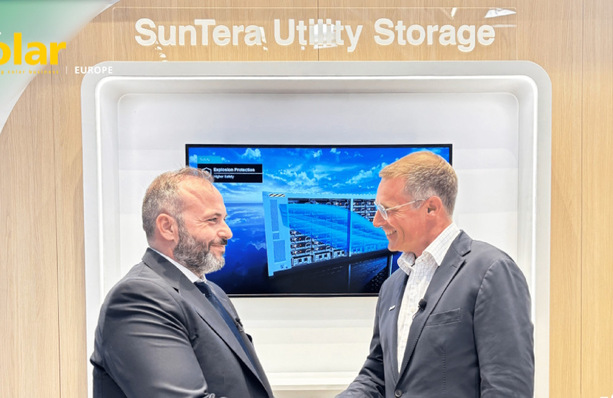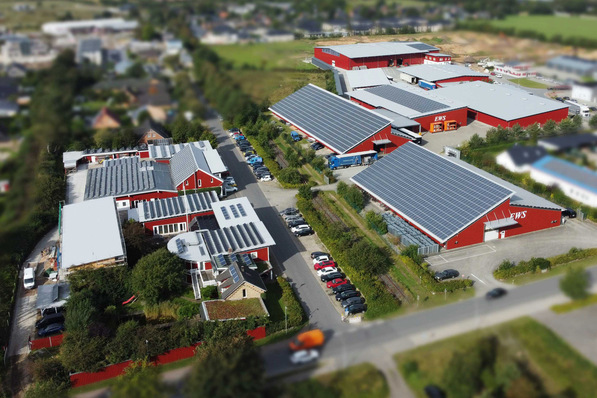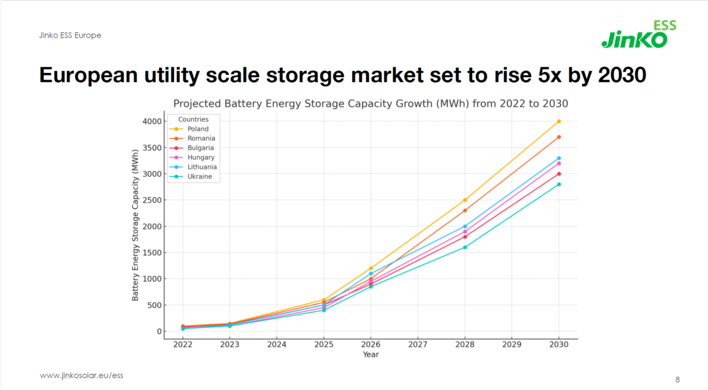Kropstädt is a stone’s throw from Wittenberg. Finding Kropstädt on a map is difficult – Wittenberg not at all. It is well known where Martin Luther nailed his theses of protest against the clerus to the church door, 500 years ago. But industry insiders should now also keep the name Kropstädt in mind. Since early August of last year, Tesvolt are building their new commercial storage units there. A staff of ten is producing about 1.6 megawatt hours’ worth of capacity.
Storage system with lithium battery cells of 200 ampere hours
The Li-60 series with 60 kilowatt hours is particularly in demand. When assembling it, Tesvolt bracket together six cells into one block, with 96 cells in one Li-60 cabinet. Within each block, the cells are connected in parallel, while the blocks in the cabinets are in series. For that reason, all sizes of the Li series are structured the same way, what varies is just the number and combination of cells or battery blocks.
Every battery block has its own sensor that continuously measures voltage and the temperature at the terminals. “Those are the two critical parameters,” Simon Schandert says. He is the chief engineer of Tesvolt and head of system development. “The cells’ temperature does not become a problem, if the pattern of charging and discharging is set up correctly. We adapt the charging specifications to the batteries, to ensure that they are charged or discharged at a rated current load of about 0.3 to 0.5 C. A temporary maximum load of 1 C in case of peak loads is not a problem.”
Measuring temperatures precisely for best performance
At temperatures below five or above 40 degrees Celsius, the load on the system is reduced. “A lithium iron phosphate battery performs best at 20 to 30 degrees, resulting in a long battery life,” Schandert explains. “That is why the current loads are reduced when temperatures go too high or too low, in order to ensure the longest battery life possible.”
At sub-zero temperatures, the storage unit switches itself off. The same is true for temperatures above 45 degrees. Recently, the first Li-60 was delivered to Siberia. Because in winter, temperatures can easily go below minus 40 degrees Celsius, the unit was set up inside the container which also is the service room for the engineer on duty. Generally, the Li storage units are designed for indoors use, without air conditioning. Four Li-60s have already been installed at London’s largest flower market (240 kilowatt hours at a charging capacity of 72 kilowatts).
Safety first
If the ambient temperature at the site of the storage unit falls below zero degrees, to be safe, the battery management system disconnects it from the grid. This avoids charging and subsequently doing damage to the battery below freezing, because otherwise there is the danger of formation of dendrites, metallic needles that could penetrate the separators. The disconnecting happens through DC relays attached directly to the battery at either terminal. These work redundantly, and so the positive and negative terminals can be (dis)connected independently of each other.
The bi-directional battery management system is the heart of the storage unit. It is the area of expertise of Simon Schandert and the technicians and engineers working with him. When the sub-assembly that contains the control unit is wired together with the battery blocks, Schandert refers to them as being a ‘match’, just as when an engine is mounted on the chassis of a car.
One system per day
A Li-60 can be assembled and be ready for shipment within a single day. Connection to the BatFuse, a fuse box for the battery, is achieved through two DC connection cables at the rear of the unit. (IR/HS)
Did you enjoy watching "A match in Kropstädt: How to make a commercial energy storage system”? Then also, watch “Moving the markets: The Tesvolt commercial energy storage system sets a benchmark for the new technology”. Or find out which opportunities Andreas Piepenbrink, the CEO at E3/DC sees for the energy storage market, or read the exclusive interview with Santiago Senn, director of LG Chem Europe on pv Europe in which he discussed innovation in storage systems, markets and distribution.






